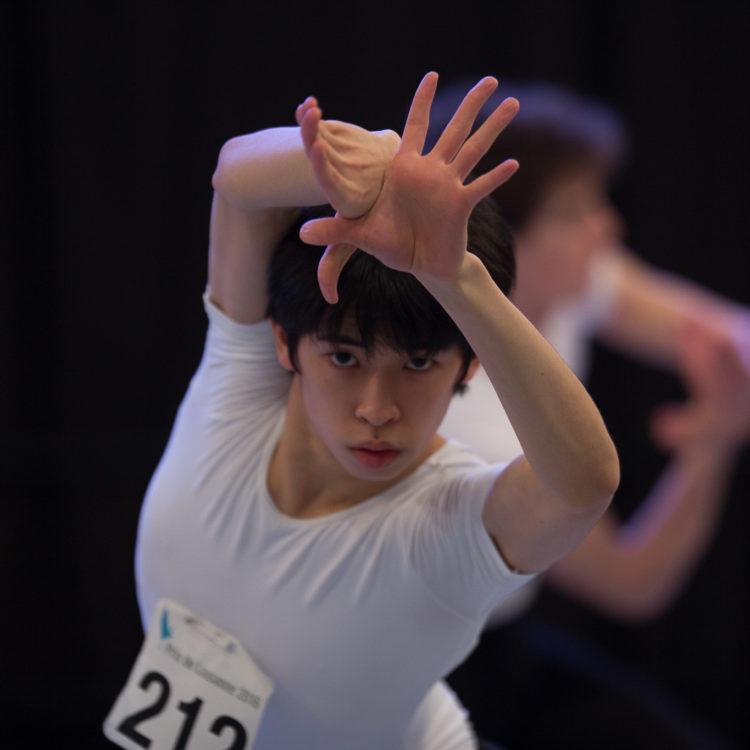10 Reasons Improvisation Should Be An Integral Part of All Vocational Ballet Training
After watching the first day of the Prix de Lausanne livestream yesterday, I have to admit, something that the Prix’s artistic director, Amanda Bennett, said during the boys improvisation workshop with Tamas Moricz has left me rather stunned at the way we train classical dancers…
Not surprised, yet stunned.
While this group of talented boys (who have probably been meticulously groomed for this prestigious event in the best schools and conservatories across the world) maneuvered their way around the space, thumbs intertwined, movements flowing, Ms Bennett made the following comment:
“It’s the first time many of these young people have done an improvisation like this.”
(Cue Philippa’s jaw hitting laptop keypad in utter disbelief).
Seriously?!
I mean, I was not totally surprised to hear this.
I know from my own experience that improvisation is not a core subject in most professional classical ballet training programs.
It’s something that for some reason gets phased out after the fairy-wands and scarf-waving of baby ballet and left for the hardcore contemporary floor-writhers, or the freestyling street dancers, but its certainly not highly regarded in rigorous ballet training.
However, I’m also dumbfounded to hear this statement, because having been a professional dancer myself, as well as a dance teacher, performance psychology teacher and counselor working with today’s dancers, I know there are so many benefits of improvisation, specifically for our upcoming classical ballet dancers, that I am just speechless to think that this huge field is being ignored.
Perhaps it is not.
Perhaps schools are doing improv with their students and Ms Bennett is simply unaware of it (please tell me you are!).
I know we had regular composition classes at the Hamburg Ballet School, because the school and company’s director John Neumeier realized that it was vital if his school was to have any hope of producing the kind of company dancers that would be capable of fulfilling his creative vision.
Whatever the case, thanks to Ms Bennett’s artistic direction, at least students are getting exposure to improvisation at the Prix de Lausanne.
But just for the record, just to get it off my chest, here are 10 reasons why ballet dancers specifically, absolutely must practice regular improvisation as part of their core vocational ballet training (…and beyond).
[pullquote]10 reasons improvisation needs to be an integral part of vocational classical ballet training[/pullquote]
When you improvise, your brain is different to when you perform a combination of steps you’ve learnt. There are a couple of different aspects of this I want to draw out here:
1) JUDGEMENT FREE ZONE
When you improvise, you’re the parts of the brain involved in self-monitoring, evaluating, correcting, judging (which for most ballet dancers would probably generally be over-active, am I right?!), wait for it…
Those parts of the brain: SWITCH OFF
OMG, can you imagine this?
Your inhibitions, the voices telling you “you’re not good enough, you look stupid, you didn’t quite get it right”… they actually. switch. off.
My, what a relief! Ballet dancers, you MUST experience this! A moment without those voices, a judgement free zone! What absolute freedom! But that’s not all…
2) GENUINE EXPRESSION
When you are improvising, the autobiographical areas of your brain, the self-expressive parts, your internal motivators all switch on, light up…
Yes, when you improvise, you actually stop just rehashing expressive mannerisms that you’ve learnt and you start being genuinely, authentically, personally, actively expressive.
Do I even need to explain why doing something that fosters genuine expression and intrinsic motivation is so important for ballet dancers?! I didn’t think so!
3) BALANCE
Ballet dance students absolutely NEED the polar opposite experience of the free movement exploration of improvisation to balance out the rigidity of classical ballet training.
Just like cross-training is essential to provide the physical strength and endurance required for elite performance that is often lacking in traditional ballet training, improvisation is also needed to provide the neural shift I mentioned above and the freedom of movement required on stage, yet often lacking in classical training.
4) TO COMBAT PERFECTIONISM
Most ballet dancers are perfectionists – which has its pros and cons! One of the problems of perfectionism is the black/white, right/wrong, good/bad dichotomous thinking that inevitably goes with it.
Perfectionists want to do things right. They want to be good.
This means they improve a lot and end up in prestigious competitions like the Prix de Lausanne, but it also means they can become very afraid of being perceived as wrong or bad, which keeps them from developing the more personal aspects of their performance, like their freedom of expression, emotional depth and artistry.
There is no good or bad, right or wrong in improvisation, there is only exploration and experimentation.
This is both the best news and the worst news for perfectionistic ballet dancers. Its’ the best news because it means there actually IS an avenue in which they can develop this side of their performance. Hallelujah!
But it’s also the worst news because in improvisation, the clearly defined rules of the classical ballet system, which are such a safe-haven for perfectionists, are suddenly out the window.
Dancers are required to engage personally, vulnerably, holistically with their movements in a moment-by-moment way, that is way out of a perfectionist’s comfort zone, creating a whole lot of anxiety (I had a friend who would drink a shot of Bailey’s before composition class, that’s how anxiety-provoking the idea of it was!)
So improvisation is something that needs to be introduced in a very gentle, non-threatening way (that’s a whole other article in itself!).
However, if ballet dancers can find a safe space where they can get past their fear of not having “right” things to do, they may just have the wonderful experience of finding freedom from the constant internal evaluation of perfectionism. Wouldn’t that be worth it?!
5) FLOW
The pinnacle of classical ballet performance is being able to dance effortlessly. As Gaynor Minden beautifully reminds us: “It’s amazing what goes into making something effortless”.
Yes, a lot of effort is involved in making your performance effortless, but so is practicing dancing effortlessly!
The unfolding nature of improvisation allows you to experience many of the characteristics of the much-desired psychological state called “flow” where your performance is effortless, uninhibited, you get lost in the moment and thoroughly enjoy the process!
Would you like to dance effortlessly? Then practice improvisation. 🙂
6) MOVING MINDFULNESS
Mindfulness meditation is pretty popular around the world these days and research shows many benefits of mindfulness on overall health and wellbeing, it is great for stress reduction, improving attention, focus and emotional resilience.
Improvisation is essentially moving mindfulness.
You are being present in your body in the present moment. So, don’t just improvise to enhance your performance, do it for your own general wellbeing too!
7) CREATIVITY
Ballet dancers are some of the least creative people on the planet.
I’m sorry, but it’s true.
Someone should do some proper statistical research on this!
As part of my performance psychology classes, in my online Believe In Yourself course and with my one-on-one clients, I use Character Strengths testing (because dancers focus way too much on their weaknesses!).
I am often (again, not surprised, but) stunned to see the results, particularly amongst females, how creativity is usually way down the bottom of dancers’ strengths lists.
Judgement, perseverance, they are up the top, the go-to strategies to make it to the top of the ballet pile. And yet at what cost to the creativity that is essential to turn a trained technical student into a performing ARTIST?!
Lisa Pavane, in her first year as director of The Australian Ballet School last year, introduced a set of defining school values, and one of them was creativity. I don’t know if she realizes just how radical this value is for a classical ballet institution.
If her vision continues to unfold and creativity is genuinely nurtured and strategically fostered, what a difference this could make on the future landscape of Australian dance!
I am excited to see this process shaped into reality, both here and around the world.
8) BE MORE THAN JUST PUTTY IN CHOREOGRAPHERS’ HANDS
Many choreographers find dancers fresh out of ballet school to be rather difficult to work with creatively (see No. 7).
Dancers are trained to do what their teacher tells them and so when they wind up in a company and a choreographer asks them to play with an idea or phrase of movement and co-create something unique with them, most budding ballerinas don’t have a clue what to do, so they freeze up and get awkward (not a good look!).
As my former director John Neumeier knows, we need to expose ballet students regularly to composition, improvisation and creative development practices, to prepare them for the very real and potentially career-making or breaking experience of working with a live choreographer in a dynamic and inspiring way.
It shouldn’t be the rare exceptions to the rule who manage to breakthrough their fears of being different or wrong or not good enough that are lapped up by choreographers and seeing their potential as performers fulfilled.
What would it be like if entire schools and companies of ballet dancers were equipped to experiment, invent, co-create and inspire? How much more impactful pieces of art would be created and would audiences witness if this were the case?
9) TO PRODUCE MORE FEMALE CHOREOGRAPHERS
There has been a lot of debate in the media about the lack of female choreographers in the industry today.
The genesis of this issue does not occur at the transition from dancer to choreographer, but way back in the ballet studio where almost all types of dancers are trained, and where the value of conformity over creativity is instilled and reinforced.
So why does this effect girls more than boys? Girls usually:
- start younger than boys
- have more direct competitors
- have higher expectations placed on them
- receive less grace for failures…
All of this means that most serious female dance students choose conformity over creativity as a more reliable means to get ahead and get a career.
Creativity gets tamed in traditional ballet training.
Without composition and improvisation being prioritized during the training years to balance this, by the time it comes to put your hand up for that young choreographer’s opportunity, your creativity is happily hidden in the bottom corner of your ballet bag under your smelly toe-pads and yesterdays’ leg warmers.
If we want to shift the gender-balance in choreographic output, we need to start valuing creativity throughout dance training.
10) WARM UP WONDERS
Lastly, and personally, my most compelling reason to improvise, is simply because it is the most energizing full body, feel good warm up you can possibly do as a dancer, as a mood-shifter, a distraction-releaser, an energy-filler, a tone-setter before any class, rehearsal or performance. You can tailor it exactly to your body’s needs in the present moment and do exactly what you need to set yourself up for what is ahead.
So there you go, 10 excellent reasons to include improvisation generously throughout vocational ballet training!
If you do indulge me and give improvisation a go and actually get to the point of allowing your inhibitions to fade away and your genuine freedom of movement to take over, would you do me a favour?
Once your improvisation comes to a close, take a moment for me, close your eyes and get a full sense of how it feels in your body to have improvised and I promise you, you will be converted.
If you like this post, please start improvising, comment, like, share, tweet etc.
🙂 Philippa
[message_box bg=”#7D171E”] The Believe In Yourself Online Course starts next week! [button size=”medium” style=”alt-button white” text=”Find out more & enrol here” link=”http://heretohelp.net.au/believeinyourself/”] [/message_box]

